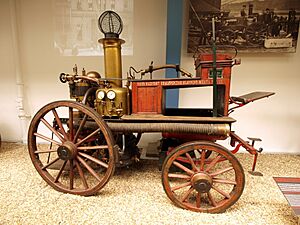Ernest Godward facts for kids
Ernest Robert Godward (born April 7, 1869 – died December 2, 1936) was a clever inventor and engineer. He was born in England but also lived in New Zealand and the United States. He is famous for inventing the spiral hairpin and a special part for car engines called a petrol economizer. This device helped engines work better and use less fuel.
Contents
Early Life and Adventures
Ernest Godward was born in Marylebone, London, England, on April 7, 1869. His father, Henry Robert Godward, was a fireman.
When Ernest was just 12 years old, he was sent to a prep school. But he decided to run away and went to sea! He traveled all the way to Japan. There, he worked on a special ship that laid underwater cables between Nagasaki and Vladivostok. Eventually, the British Consul, Nicholas Hannen, helped him return home.
Back in London, Ernest became an apprentice at a company called Shand, Mason and Co. This company made steam-powered fire engines and other hydraulic machines. He trained there as a mechanic. In 1884, he left Shand Mason and went back to sea, working as a ship's steward.
In 1886, Godward moved to New Zealand. He arrived at Port Chalmers on a sailing ship called the Nelson on December 31. While living in Dunedin, he learned to play the banjo. He even started a music group called the Star Variety Company. He worked in a bicycle shop before moving to Invercargill in 1893. In Invercargill, he became a partner in a bicycle business called Southland Cycle Works. They made bikes called Sparrowhawk cycles. On January 28, 1896, he married Marguerita Florence Celena Treweek. They had 10 children together, including Marguerita's niece.
Amazing Inventions
After leaving the Southland Cycle Works in 1900, Godward started inventing many different everyday items. Some of his inventions included an egg-beater that wouldn't slip, a new tool for digging post holes, and a new type of hair curler. He also designed a window that was hard for burglars to open. He even made a hedge trimmer using parts from bicycles!
He started a company called Godward Spiral Pin and New Inventions Co Ltd. This company was even listed on the New Zealand stock exchange.
His biggest financial success came in 1901. This was thanks to his invention of the spiral hairpin. He had patented this invention in 1899. Godward sold the rights to his spiral hairpin in the U.S. for £20,000. This was a huge amount of money back then!
Community and Sports
From 1903 to 1906, Godward was a member of the North Invercargill Borough Council. This meant he helped make decisions for his local town. He was also very artistic. He painted portraits and landscapes. He played many musical instruments and sang in local shows. In 1908, he was part of the first hot air ballooning event in Southland!
Godward was also a talented sportsman. He cycled for the Invercargill Cycle Club. He enjoyed running, swimming, rowing, and boxing. He even helped start the Invercargill Amateur Swimming Club in 1903. In 1909, Godward and Robert Murie won a car race from Invercargill to Dunedin and back. A few weeks later, they were in another race but crashed while trying to avoid a horse-drawn cart. This race caused some concern from the police and local groups.
Rockhaven: Godward's Home
From 1905 to 1908, Godward built a beautiful new house called Rockhaven. It was located at 397 Queens Drive in Invercargill. The house was designed by an architect named Peter Walker. Rockhaven is a great example of the Queen Anne style and is considered an important historic place.
Godward's wife lived in Rockhaven until 1946. The house is still a private home today. The garage where Godward worked on his inventions was still standing in 2013.
Court Case Witness
In 1908, Godward was a witness in a court case known as the Coldstream shooting case. A woman named Maud Buchanan was accused of shooting Vera McKay. The court case found that Mrs. Buchanan did not intend to seriously harm Mrs. McKay. Instead, she wanted to scare the McKays to stop them from sending anonymous letters. Mrs. Buchanan was found not guilty. Godward was present during the incident and later gave his testimony in court.
The Petrol Economiser
In 1908, Godward opened his own bicycle business. After a short time, he started importing Reo cars. He then focused on making these cars better. In 1912, he invented a special part for car engines called the Eclipse Petrol Economiser.
In 1913, he took his invention to London, England. He started the Godward Carburettor Company there and patented his device in 1914. This invention wasn't as successful as he hoped in England. So, in 1916, Godward opened an office in New York, in the United States.
In 1926, he made an even better version of his invention, which he called the Godward Vaporiser. This Vaporiser allowed cars to use a different type of fuel, like fuel oil, instead of just petrol. A large public transport company in Philadelphia called the Mitten Company started using his invention. They fitted the Vaporiser to about 580 buses and 3000 taxis! It was said to make engines 15% more powerful.
The United States Army also tested the Vaporiser successfully at Camp Holabird. In total, Ernest Godward created 72 different types of carburetors.
Later Life and Legacy
Godward lost a lot of money in the stock market crash of 1929. However, he managed to recover some of his losses. In his later years in the United States, he was known as one of the world's top experts on internal combustion engines.
Ernest Godward died from a heart attack on December 2, 1936. He was on board a ship called the SS Mongolia, returning home to Invercargill. The day before he died, he had even won a skipping contest on the ship!
See also


